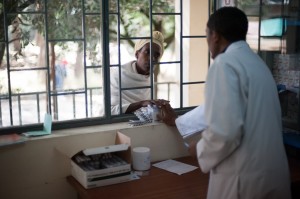By Emmanuel Nfor

The availability of new and essential medicines and other health technologies to treat life-threatening illnesses have helped millions of people lead long and productive lives. However, global availability does not necessarily mean access by the end-consumer to these lifesaving health products in low-and middle-income countries. Effective supply chains are needed to deliver these health products in hard-to-reach, resource-constrained settings that often times are inhospitable to collaborative, high-performing supply chain systems.
So how do we get safe, quality, essential medicines and commodities to the people who need them, at the right time and in the right quantities?
First, we need to rethink how we can better support a healthy supply chain.
Health technologies move through a mix of public, non-governmental and private sector channels. Traditionally, supply chains have been viewed as a network of independent entities, and performance improvement efforts are focused on separate functional areas. For example, improvements in quantification of needs may not be matched by better warehousing and transportation operations, which are crucial for meeting the requirements of the end-consumer.
Lessons learned from customized or “parallel” supply chains for HIV, malaria, tuberculosis and other health programs can help us develop new supply chain management systems. Collaboration between governments, non-governmental organizations (NGOs), and international partners that serve the same target populations improve service to end-consumers, and reduce total supply chain management cost.
Experience has also shown that governments and development partners should:
- Move towards a more collaborative procurement strategy. A win-win collaborative relationship between buyer and supplier will increase supply chain visibility and commodity availability, thereby removing inefficiencies. For example, the Supply Chain Management System (SCMS), funded by PEPFAR, uses a pooled procurement system for HIV and AIDS commodities across 22 countries. The high volume and frequency of procurement, averaging $25 million with 260 deliveries, opened a window for SCMS to develop close working relationships with suppliers and freight forwarders. These collaborative relationships have resulted in SCMS being able to leverage best value and ensure the availability of commodities and space on shipping routes
- Integrate planning for all key supply chain management functions, for example, connecting quantification of needs with warehousing and transportation requirements within and across programs. The underlying principle is that components, or parts of the supply chain, have functional relationships, which require tradeoff decisions. Carefully balanced decisions will eliminate waste from supply chains. When SCMS first began working in Guyana in 2006, one of the most urgent activities was collaboration with the Ministry of Health (MoH) to accurately forecast demand for a wide range of health commodities, including those vital to the diagnosis or treatment of HIV. SCMS and the MoH also recognized that the supply chain was compromised by a poor warehousing infrastructure and medicines were not stored with adequate temperature controls and general safeguards. As SCMS and the MOH began a comprehensive upgrade of the national warehousing system, their actions were informed by supply plans and forecast data that addressed warehouse requirements such as size and location. Today, Guyana has a world class warehouse that is deeply integrated into the overall national supply chain.
- Emphasize ‘total supply system performance’ as opposed to function or program bias. Components or part of the supply chain need not have optimum performance. Investments in an isolated function of the supply chain have limited value. USAID-funded Systems for Improved Access to Pharmaceuticals and Services (SIAPS) uses pharmaceuticals as the entry point to a comprehensive supply chain management system. SIAPS uses a systems approach for strengthening supply chain management. This involves supporting continuous improvement of processes across the full spectrum of supply chain management functions, including procurement, warehousing and inventory management, transportation management and the information systems. Total supply system performance is therefore demonstrated by the availability of medicines and other health technologies at service delivery points.
The US Government has committed significant financial and technical resources to global initiatives such as “Creating an AIDS-Free Generation” and promoting child survival through “A Promise Renewed” and other global partners contribute to the success. Management Sciences for Health is a partner in the government’s efforts to improving health outcomes worldwide through projects such as USAID-funded Systems for Improved Access to Pharmaceuticals and Services and the Supply Chain Management System.
An effective, well-functioning supply chain brings us one step closer to achieving the goal of improved health outcomes for people around the world.
Emmanuel Nfor, Principal Technical Advisor for Supply Chain Management, Systems to Improve Access to Pharmaceuticals and Services (SIAPS) program at MSH, provides global technical leadership and strategic direction to SIAPS’ innovative supply chain programs. He also works to integrate industry best practices into the program’s overarching capacity building and technical assistance activities.

